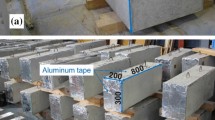Abstract
Results of a wide-ranging investigation of the abrasion resistance of concrete are reported and the influence of water/cement ratio, curing, workability, maximum aggregate size and the constituent materials is discussed. Various other tests, namely compressive strength, rebound hardness and permeation (initial surface absorption, intrinsic permeability and vapour diffusivity) are examined for their ability to predict the abrasion resistance of concrete. The initial surface absorption test is recommended for this purpose.
Resume
On rend compte d'une vaste étude de la résistance à l'abrasion du béton, et on discute l'influence du rapport eau/ ciment, de la conservation, de l'ouvrabilité, de la dimension maximale des granulats et des matériaux constitutifs. On examine divers autres essais, tels que résistance à la compression, dureté au scléromètre, perméation (absorption superficielle initiale, perméabilité intrinsèque et coefficient de diffusivité de la vapeur d'eau) en fonction de leur aptitude à prévoir la résistance à l'abrasion du béton. On recommande l'essai d'absorption superficielle initiale.
Similar content being viewed by others
References
Rushing, H. B., ‘Concrete wear study’, Report PB 183410 (Louisisiana Department of Highways, 1968).
Chaplin, R. G., ‘Abrasion resistant concrete floors’, in ‘Advances in Concrete Slab Technology’, edited by R. K. Dhir and J. G. L. Munday (Pergamon, 1980) pp. 532–543.
Sadegzadeh, M. and Kettle, K., ‘Indirect and non-destructive methods for assessing abrasion resistance of concrete,’,Mag. Concr. Res. 38(137) (1986) 183–190.
Tomsett, H. N., ‘Non-destructive testing of floor slab’,Concrete 8(3) (1974) 41–42.
Connell, M. D., ‘A study of an abrasion test for concrete and some of the factors affecting abrasion resistance’, C&CA ACT Project (1985).
Dhir, R. K., Hewlett, P. C. and Chan, Y. N., ‘Near surface characteristics and durability of concrete: an initial appraisal’,Mag. Concr. Res.,38 (134) (1986) 54–56.
Idem,, ‘Near-surface characteristics of concrete: assessment and development ofin situ test methods’,39 (141) (1987) 183–195; also ‘Discussion’, (1988) 240–250.
Idem,, ‘Near-surface characteristics of concrete: intrinsic permeability’,41(147) (1989) 87–97.
Idem Dhir, R. K., Hewlett, P. C. and Chan Y. N. ‘Near-surface characteristics of concrete: prediction of carbonation’,ibid. Mag. Concr. Res. 41 (148) (1989) in press.
Cement and Concrete Association, Annual Report (1979).
British Standards Institution, BS1881 Part 202: 1986, ‘Method of testing concrete, surface hardness’.
Dhir, R. K., Levitt, M. and Wang, J., ‘Membrane curing of concrete: water vapour permeability of curing membranes,’,Mag. Concr. Res. 41(149) (1989) 221–229.
Author information
Authors and Affiliations
Rights and permissions
About this article
Cite this article
Dhir, R.K., Hewlett, P.C. & Chan, Y.N. Near-surface characteristics of concrete: abrasion resistance. Materials and Structures 24, 122–128 (1991). https://doi.org/10.1007/BF02472473
Issue Date:
DOI: https://doi.org/10.1007/BF02472473




